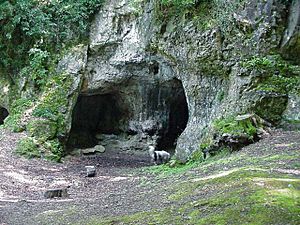King Arthur's Cave facts for kids
Quick facts for kids King Arthur's Cave |
|
|---|---|

The entrance to King Arthur's Cave
|
|
| Location | Lord's Wood, The Doward, Symonds Yat, England |
King Arthur's Cave is a cool limestone cave in Herefordshire, England. You can find it at the bottom of a small cliff in Lord's Wood, near Symonds Yat. It's about four miles northeast of Monmouth, right in the beautiful Wye Valley.
The cave entrance is quite high up, about 285 feet above the River Wye. It has a special double entrance that connects inside to two main rooms. This amazing cave is protected as a nature reserve by the Herefordshire Nature Trust. Scientists have found proof that people lived here a very long time ago, during the Upper Paleolithic period. They've even dug up flint tools and bones from huge woolly mammoths in and around the cave!
Contents
Why is it Called King Arthur's Cave?
It's a bit of a mystery how this cave got its famous name. Around the year 1700, people said a skeleton of a "giant human" was found here. But sadly, it was lost when a local surgeon took it on a ship to Jamaica, and the ship sank.
The cave is also part of many local stories and old beliefs. Some think it played a role in the early legend of King Vortigern. He was a British king who fought against invaders called the Anglo-Saxons. People say Vortigern made his last stand nearby. An old writer named Lawman even mentioned a castle on Cloard Hill in this area. He wrote that Vortigern died after his castle was attacked and burned.
A writer named Helen Hill Miller suggested in 1969 that the cave might have been used for military purposes. She thought its deep "recesses" could hide a large group of soldiers. It's similar to Cadbury Castle, Somerset, which is also a cave found within an ancient hillfort.
Exploring the Cave's Past
Many years ago, people started digging to learn more about King Arthur's Cave.
Early Discoveries (1871)
In 1871, a Reverend named William S. Symonds began exploring the caves. He started digging after he heard that some miners had been taking things from them. He made some amazing finds! He unearthed bones from many ancient animals, including hyenas, lions, brown bears, red deer, rhinoceros, Irish elk, reindeer, and horses. These bones were from the Late Pleistocene period, which was a very long time ago.
He found a lot of hyena bones, and many of them had marks from being crunched by these powerful animals. Reverend Symonds also discovered flint tools from the Upper Palaeolithic period. Plus, he found pieces of Neolithic pottery, showing that different groups of people used the cave over time.
More Digs and Amazing Finds
Members of the Cotswold Naturalists' Field Club also explored the caves with Reverend Symonds. They first looked at another cave about 200 yards from King Arthur's Cave. This cave was almost completely blocked by dirt and rocks. After clearing it, they found a hard, stony floor. Underneath it were bones of fowls, sheep, and pigs. Even deeper, about five feet down, they found a large forearm bone from an elephant! They also found a Roman ox head near beaver remains.
Next, the group visited King Arthur's Cave itself. This cave actually has two openings and a long passage. The club named one part "The Bear's Den" and the other "The Lion's Cave." In The Bear's Den, after digging 22 feet down, they found bones of beavers, badgers, roedeer, wolfs, and reindeer.
Even deeper inside, Reverend Symonds showed them a truly remarkable discovery. They had dug about 10 feet into the cave floor. Here, they found layers of river sand and pebbles between two stony floors. On the top stony floor, mixed with earth, were more bones of extinct animals.
Later Excavations
Between 1925 and 1927, a group called the University of Bristol Spelæological Society (UBSS) continued digging. In 1926, a scientist named Garrod looked at their findings. He said that the items from the upper part of the cave were from the Upper Palaeolithic period. Things found in the lower part were from the Middle Palaeolithic period. The society came back in 1955 but didn't find anything new.
In 1989, King Arthur's Cave and the nearby Upper Wye Gorge (about 3.7 acres) were officially named a Site of Special Scientific Interest (SSSI). This means they are very important for their natural features and wildlife.
Cave Structure
King Arthur's Cave has a wide entrance area. It features a double entrance that connects inside to two main rooms. These rooms are about 300 feet above the River Wye. One of the main rooms is large and round, about 25 feet across.
The two main rooms were named "Bear's Den" and "Lion's Cave." This is because of all the ancient animal bones found there, including bears and lions! There are also several other open areas inside the cave.

